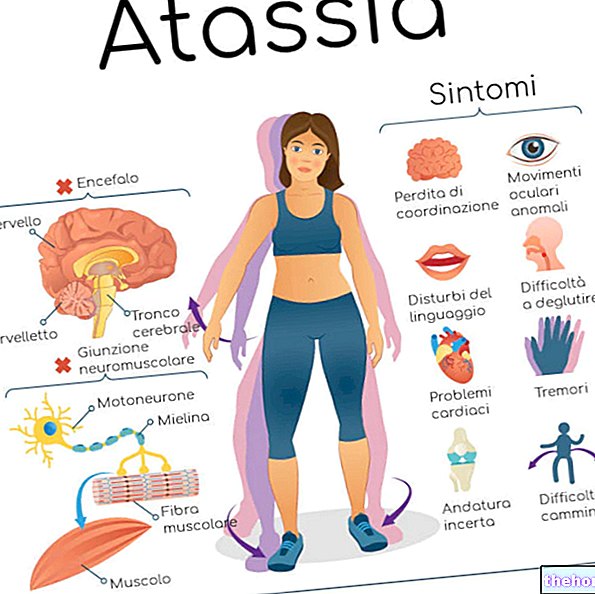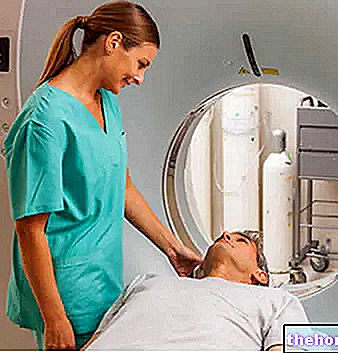Generality
Trigeminal neuralgia is a neuropathic disorder, manifested by intense facial pain. An attack of trigeminal neuralgia can occur without warning and be triggered by stimulating specific areas of the face, even in the course of simple daily actions, such as brushing your teeth, talking, or chewing. The pain lasts from a few seconds to several minutes and affects one or more branches of the trigeminal nerve (also called the fifth cranial nerve). Trigeminal neuralgia is diagnosed with history, physical examination, and imaging techniques. The latter are often useful to exclude other causes of facial pain (tumor, aneurysm, multiple sclerosis, etc.), conditions that must be managed and treated appropriately. Trigeminal neuralgia is a chronic (long-term) disease; if left untreated, it often tends to worsen over time, with attacks followed by shorter and shorter periods of remission. Although trigeminal neuralgia is currently not curable, there are several treatments available that can effectively relieve pain.
Treatment options for trigeminal neuralgia include:
- Pharmacological therapy;
- Surgical therapy;
- Complementary approaches.
The first approach consists of drug therapy. In many cases, anticonvulsant and antidepressant drugs are prescribed, as they are often found to improve neuropathic pain. However, drug therapy provides only temporary relief over time and some patients may become refractory to drugs. If trigeminal neuralgia is severe, or if the drug is not effective or causes unpleasant side effects, surgery may be considered. The purpose of neurosurgery is to "eliminate the causes that trigger neuralgia by acting on the blood vessels that compress the trigeminal nerve or on the nerve cells responsible for pain. Research shows that surgery provides effective long-term symptomatic relief, so much so that in 70-90% of treated cases are unlikely that trigeminal neuralgia will recur. This last possibility depends mainly on the type of surgery used. Furthermore, since it is still an invasive treatment, potential side effects, such as hearing loss or facial numbness, must also be considered before adopting this solution. If the trigeminal neuralgia is secondary, then caused by other causes such as multiple sclerosis or a tumor, the doctor will treat the underlying condition.
Medicines
Drugs can provide temporary relief from trigeminal neuralgia symptoms by decreasing or blocking pain signals sent to the brain. First-line therapy involves prescribing anticonvulsants (usually used to treat epilepsy), which work primarily by slowing down electrical impulses that cross the trigeminal nerve. Carbamazepine is usually the first-line anticonvulsant drug. effective in the treatment of trigeminal neuralgia, as it reduces painful symptoms. However, carbamazepine can cause several side effects and toxic reactions, which can make it difficult to manage trigeminal neuralgia in some patients. Also for this reason, anticonvulsants must be taken under strict medical supervision If carbamazepine decreases its effectiveness, your doctor may increase the dose or change the treatment protocol.
The possible side effects of carbamazepine are described below:
Less common side effects
Uncommon side effects
Nausea and / or vomiting;
Dizziness;
Feeling sick and tired
Leukopenia (reduction in the number of white blood cells);
Abnormal levels of liver enzymes.
Increased risk of bruising or bleeding
Weight gain and fluid retention;
Confusion;
Headache;
Vision disturbances (blurred or double vision);
Dry mouth
Involuntary movements (example: tremors);
Abnormal eye movements
Diarrhea;
Constipation.
If carbamazepine is not tolerated by the patient, other anticonvulsant drugs (oxcarbazepine, clonazepam and gabapentin) may be prescribed. However, in general, the anticonvulsants used for trigeminal neuralgia may lose their effectiveness over time, because they are only effective in relieving pain but do not act on the underlying cause.
Second-line treatment
- Other medications include some muscle relaxants such as baclofen, which can be taken alone or in combination with carbamazepine. Side effects can include confusion, nausea, and sleepiness.
- Low doses of some tricyclic antidepressants, such as amitriptyline or nortriptyline, may be effective in the treatment of neuropathic pain, but their use is often limited to the treatment of depression associated with chronic pain.
- Pain relievers, such as acetaminophen and NSAIDs, are not effective in treating trigeminal neuralgia (they can only be used in very mild cases).
If the drug fails to relieve pain or produces intolerable side effects, surgical treatment may be recommended.
Surgery
Several neurosurgical procedures are available today for the treatment of trigeminal neuralgia. The choice between the various options is made on the basis of the patient's state of health and clinical history, considering previous surgery, the possible presence of multiple sclerosis and the area of involvement of the trigeminal nerve.
In particular, surgery may be recommended for trigeminal neuralgia if:
- The patient complains of severe pain in the face and severe muscle spasms, despite the ongoing drug therapy;
- Any of the bodily senses are affected by neuralgia;
- Anticonvulsants are no longer effective in controlling pain;
- Conventional therapy has resulted in the onset of serious side effects;
- The patient is less than 40 years old.
The goal of surgery applied to neuralgia is to correct the position or structure of the blood vessel that compresses the trigeminal and damages it, causing it to malfunction in the transmission of signals.
Surgical options for trigeminal neuralgia are:
- Microvascular decompression;
- Ablative treatments.
Some procedures are performed on an outpatient basis, while others may require a more complex "operation that requires" general anesthesia. After most of these surgical procedures, some degree of facial numbness is common, which may be temporary or permanent. The pain may return after months or years, despite the initial success of the therapy. Depending on the procedure. Other surgical risks are possible, including hearing loss, balance problems, infections and strokes.
Microvascular decompression
Microvascular decompression is the most invasive surgery foreseen for the treatment of trigeminal neuralgia, but it is also the one that offers the lowest probability that the pain will return. This procedure relieves the pressure that the blood vessels exert on the trigeminal nerve .

For many people, microvascular decompression can successfully eliminate or reduce pain and - of all available interventions - appears to provide the longest lasting outcome. For example, it has been seen that in over 70% of operated people, pain relief it was still present 10 years after surgery. However, this type of surgery has some risks (unusual and often temporary), including decreased hearing (in less than 3% of cases), loss of sensation in the face and visual disturbances. Very rarely, this type of surgery surgery can cause stroke, hydrocephalus, meningitis, or even death.
Stereotaxic radiosurgery
Stereotactic radiosurgery uses a concentrated beam of highly focused radiation at the trigeminal branch to try to reduce or eliminate pain signals that travel along the nerve path.

Other possible procedures
Rhizotomy can be used to treat trigeminal neuralgia and involves the destruction of selected nerve fibers to block pain.
Several forms of rhizotomy are available for the treatment of trigeminal neuralgia:
- Glycerol injection: This is an outpatient procedure in which the patient is sedated intravenously. The doctor inserts a thin needle in the cheek, near the mouth, which is guided towards the trigeminal ganglion, in the base of the skull (where the three branches of the trigeminal nerve rejoin). The doctor guides the needle into the trigeminal cistern, a small sac of spinal fluid that surrounds the nerve and part of its root. Doctors inject a small amount of sterile glycerol, which damages the trigeminal nerve and blocks pain signals. This procedure temporarily relieves pain, for about 6-12 months.
- Compression with balloon. The procedure is performed under general anesthesia. The surgeon inserts a hollow needle (cannula) through the patient's face, which is guided along a branch of the trigeminal nerve. A thin, flexible catheter, with a balloon positioned at the end, is threaded through the cannula and inflated with enough pressure to damage the trigeminal nerve and block pain signals. After 1 minute the balloon is deflated and removed, along with the The damage created by the balloon successfully controls pain in most people, at least for a period of time, however some patients may experience temporary or permanent weakness of the chewing muscles.
- Trigeminal radiofrequency thermorizotomy. Electrical stimulation is used to selectively damage nerve endings associated with pain. The patient is anesthetized and a hollow needle is passed through the cheek to the trigeminal ganglion. Once the needle is in place, the patient is awakened from sedation and a mild electric current is sent through the tip of the electrode. This stimulus causes tingling in the area where pain typically occurs. The patient is sedated again and the part of the nerve involved is gradually heated with an electrode, until the nerve fibers are damaged. If the pain is not eliminated, the doctor can create further injuries. Trigeminal radiofrequency thermorizotomy usually results in some temporary facial numbness after the procedure.
Research has shown that approximately 90% of people will gain immediate pain relief after radiofrequency trigeminal thermorizotomy, glycerol injection, or balloon compression procedures. However, 50% of patients can permanently lose sensation in the area being treated.Other complications can include blurred or double vision, chewing problems, dysesthesia (annoying numbness) and very rarely painful anesthesia. The benefits of surgery must always be carefully weighed against the risks. Although a large percentage of patients with trigeminal neuralgia report pain relief after surgery, there is no guarantee that the surgery will permanently resolve the condition.
Complementary therapies
Some patients choose to manage trigeminal neuralgia using complementary techniques, usually in combination with drug treatment. Alternative therapies for trigeminal neuralgia offer varying degrees of success and include acupuncture, electrical nerve stimulation, meditation and other relaxation techniques. Few clinical studies have been conducted to date on the effectiveness of these alternative treatments, so no there is still "evidence to support their use for trigeminal neuralgia."
Continue: Drugs for the Treatment of Trigeminal Neuralgia "




























